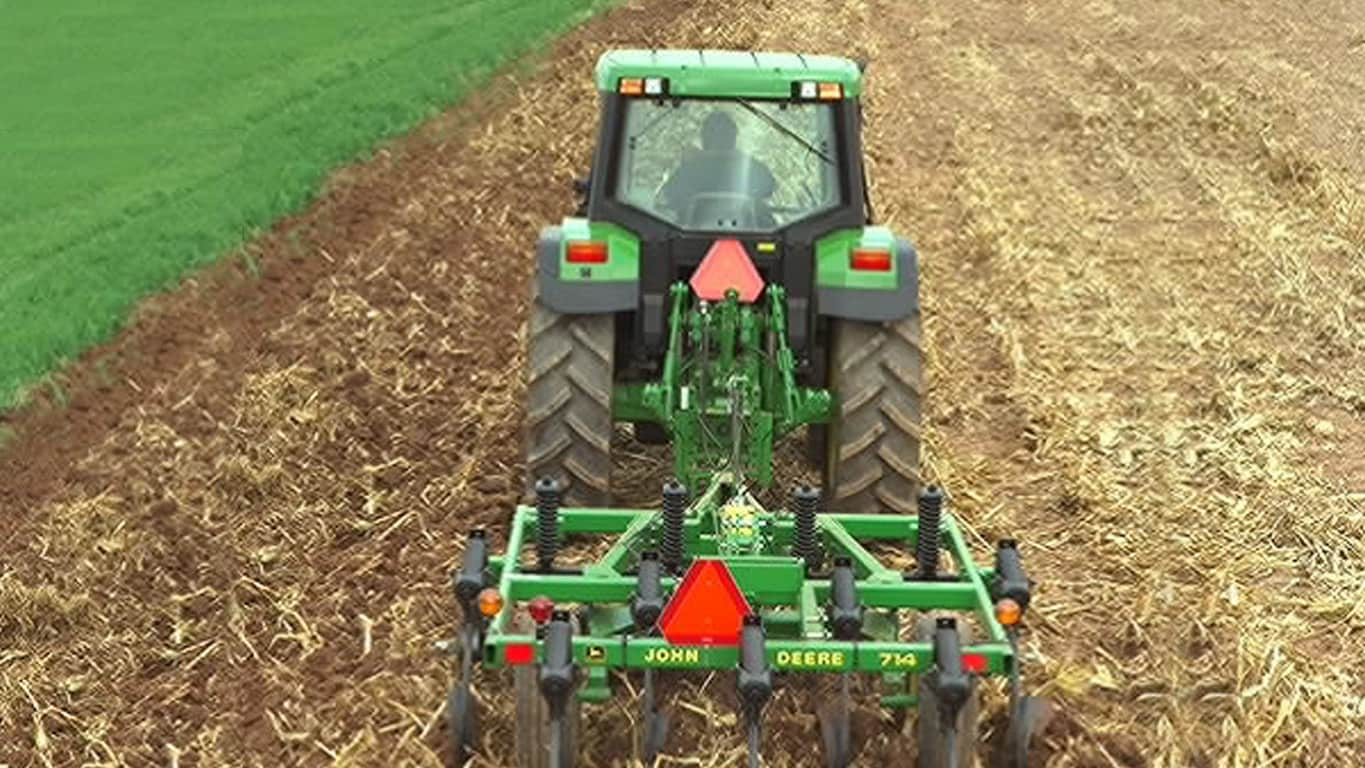Overview
- Simple gang depth adjustment
- Coulter gangs
- Three-bar frames
- Stabilizer wheels
Features
Features
Crank-adjust depth control available
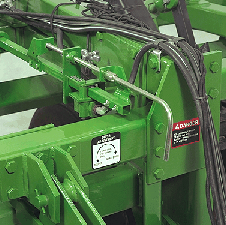 Simple, one-location depth control
Simple, one-location depth control

The crank-adjust single-point depth control is standard equipment on all models and offers the following benefits:
- More precise adjustment when changing the operating depth
- Easy access at the front of the machine
- Accurate, repeatable depth control
Simple gang depth adjustment
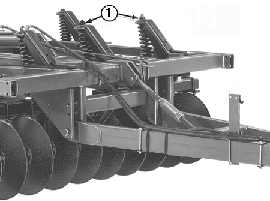 Mechanical depth adjustment
Mechanical depth adjustment

The three-bar disk gang model features a mechanical depth adjustment:
- Depth adjuster bolts (1) allow adjustment of individual gangs up or down within a 140-mm (5.5-in.) range.
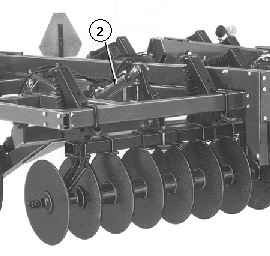 Hydraulic depth adjustment
Hydraulic depth adjustment

An optional hydraulic depth adjustment (2) is available:
- Allows on-the-go hydraulic adjustments to be made from the tractor seat
- Gangs adjust up or down within a 140-mm (5.5-in.) range
Three-bar frames offer strength
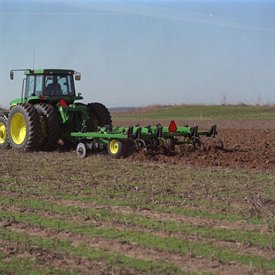 Three-bar frame of the 714 Mulch Tiller
Three-bar frame of the 714 Mulch Tiller
The three-bar frame:
-
Is constructed of three ranks of standards
- Has strength to match higher horsepower tractors
- Handles heavier residue levels
Three-bar frame models have these strength features:
- One-piece welded construction
- Solid steel in rear mainframe member
- 102-mm x 102-mm (4-in. x 4-in.) cross members
- 51-mm x 102-mm (2-in. x 4-in.) side members
- 76-mm x 127-mm (3-in. x 5-in.) diagonal frame supports
Long, narrow hitch for good maneuverability in tight headlands
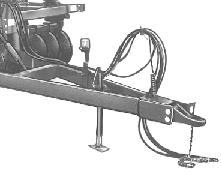 714 long, narrow hitch
714 long, narrow hitch
The long narrow hitch design:
- Allows good maneuverability in tight headlands
- Is constructed of 51-mm x 127-mm (2-in. x 5-in.) steel tubing for strength
- Heavy cast-steel hitch link for yoke-type drawbars is standard equipment
- Hitch clevis is available for use with straight drawbars (not recommended for tractors over 150 engine hp)
A Level-lift™ linkage with easy turnbuckle leveling enables the mulch tiller to remain level whether in transport or in the field position.
A hitch jack is included with all models for storage and easier hookup to the tractor.
Coulter gangs
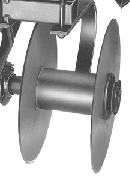 Coulter gangs
Coulter gangs

Coulter blades are for use where little incorporation is desired or for erosion-prone areas where it is important to disturb as little residue as possible. Blades are on 229-mm (9-in.) spacing to reduce the chance of plugging.
- Two-position blade down-pressure adjustment ensures consistent blade down pressure in light- or heavy-residue conditions.
- Coulter gangs have rigid scraper bars.
- Dura-Flex™ bearings and welded steel spools provide reliable performance and durability.
- Gangs are spring-cushioned with 140 mm (5.5 in.) of vertical travel to provide protection against rocks or other obstructions.
Choice of rigid, spring-reset, or Tru-Depth™ standards
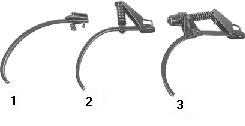 714 Mulch Tiller standards
714 Mulch Tiller standards
Rigid standard (figure 1):
-
In base equipment on all models
-
32 mm x 51 mm x 813 mm (1.25 in. x 2 in. x 32 in.)
-
Economical design is suited for fields having few obstructions
-
Till to a maximum depth of 279 mm (11 in.)
-
Good clearance to handle heavy trash
-
813 mm (32 in.) of underframe clearance
-
381-mm (15-in.) center-to-center spacing
-
Spring-reset 813-mm (32-in.) standard (figure 2):
- Optional on all models
- 32 mm x 51 mm x 813 mm (1.25 in. x 2 in. x 32 in.)
- Suited for fields having rocks or other obstructions
- Till to a maximum depth of 279 mm (11 in.)
- Trip height of 254 mm (10 in.) for good clearance
- 296-kg (650-lb) trip force
- Automatically resets to the original working position after clearing an obstruction
- Good clearance to handle heavy trash
- 813 mm (32 in.) of underframe clearance
- 381-mm (15-in.) center-to-center spacing
Tru-Depth standard (figure 3):
- Optional on all models
- 51 mm x 32 mm x 813 mm (2 in. x 1.25 in. x 32 in.)
- Edge bent for extra strength
- Designed to work in rocky ground and heavy draft conditions
- Till to a maximum depth of 279 mm (11 in.)
- Trip height of 279 mm (11 in.) for excellent clearance
- 568-kg (1250-lb) trip force
- Once an obstruction is cleared, the standard automatically returns to its original working position
- Excellent clearance to handle heavy trash
- 813 mm (32 in.) of underframe clearance
- 381-mm (15-in.) center-to-center spacing
Variety of ground-engaging tools available to match conditions
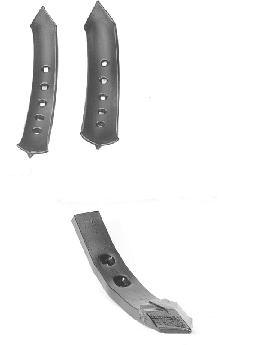 Shovels and points
Shovels and points
A variety of shovels are available to match conditions:
- 76-mm x 610-mm (3-in. x 24-in.) concave twisted shovels for use in a wide range of average soil conditions are base equipment.
- 102-mm x 610-mm (4-in. x 24-in.) concave twisted shovels for use in light, sandy soils or where greater fracturing between the standards is desired, are optional equipment.
- 51-mm x 305-mm (2-in. x 12-in.) chrome carbide point chisel provides excellent strength and wear life in tough-to-penetrate conditions.
Remaining residue cover
Typical percents of residue cover remaining are listed in the table. The percentages do not take into account variables such as the condition of the residue, speed and soil type.
Starting residue cover (percent) |
Remaining non-fragile* residue cover (percent) |
Remaining fragile** residue cover (percent) |
||||
|
with 2-in. x 14-in. shovel |
with 3-in. x 24-in. shovel |
with 4-in. x 24-in. shovel |
with 2-in. x 14-in. shovel |
with 3-in. x 24-in. shovel |
with 4-in. x 24-in. shovel |
100 |
65 |
55 |
50 |
45 |
40 |
35 |
90 |
55 |
50 |
45 |
40 |
35 |
30 |
80 |
50 |
45 |
40 |
35 |
30 |
28 |
70 |
45 |
38 |
35 |
30 |
28 |
25 |
60 |
40 |
33 |
30 |
27 |
25 |
20 |
50 |
32 |
27 |
25 |
22 |
20 |
17 |
40 |
25 |
22 |
20 |
18 |
15 |
14 |
*Non-fragile residue includes crops like corn, sorghum, wheat (more than 45 bu).
**Fragile residue includes crops like soybeans, edible beans, peas, wheat (under 45 bu), sunflower, peanuts, cotton.

